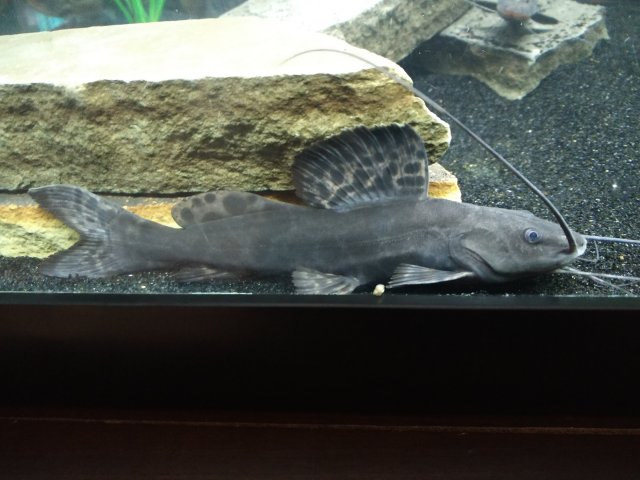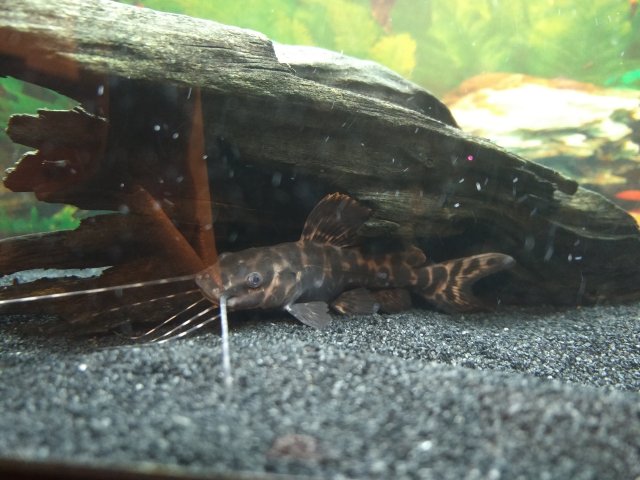Achara catfish lose of color
- Thread starter herman moorr
- Start date
You are using an out of date browser. It may not display this or other websites correctly.
You should upgrade or use an alternative browser.
You should upgrade or use an alternative browser.
hmm.. It's possible but my smaller one still has his full color. I always thought darker substrates showcases fish colors better than lighter substrates. I use black sand in all of my aquariums except my 210Maybe the substrate.
Maybe not enough places to hide, so hes trying to blend into the sand more.
What are its tankmates? It could be stress coloration from being bullied.
What are its tankmates? It could be stress coloration from being bullied.
There are plenty of hiding areas in the setup. Only tank mates are false tigrinis, retail payara,and Goliath tiger.Maybe not enough places to hide, so hes trying to blend into the sand more.
What are its tankmates? It could be stress coloration from being bullied.
I don't think there is anything worrisome here. The fish looks good. It's on the dark side and that may be because of the substrate, as stated above. In fact, IMHO, it is by far and large the most likely cause. No need to invent other explanations.
The younger fish may not have the ability to blend in as well as the bigger fish simply because of the age. Or could be the gender difference. Or that it spends more time in hiding during day hours.
Black substrate brings out colors in non-benthic fish, I'd think. Benthic fish, that is the ones that live on the bottom, will invariably try to blend in with the bottom, unless/until a breeding season, territorial disputes, what not, that requires visibility.
Bullying stress usually causes paleness, the opposite of what we observe here.
It is possible that your specimen is melanistic = a mutant that has excess of pigment, the opposite of leucism, albinism, etc. It's very rare but happens. This usually waxes and wanes, comes and goes, as in piebald fish too.
The younger fish may not have the ability to blend in as well as the bigger fish simply because of the age. Or could be the gender difference. Or that it spends more time in hiding during day hours.
Black substrate brings out colors in non-benthic fish, I'd think. Benthic fish, that is the ones that live on the bottom, will invariably try to blend in with the bottom, unless/until a breeding season, territorial disputes, what not, that requires visibility.
Bullying stress usually causes paleness, the opposite of what we observe here.
It is possible that your specimen is melanistic = a mutant that has excess of pigment, the opposite of leucism, albinism, etc. It's very rare but happens. This usually waxes and wanes, comes and goes, as in piebald fish too.
Good stuff thanks..I know he eats well and shows no signs of sickness. I've kept several of these over the years and I've never seen one get this dark.I don't think there is anything worrisome here. The fish looks good. It's on the dark side and that may be because of the substrate, as stated above. In fact, IMHO, it is by far and large the most likely cause. No need to invent other explanations.
The younger fish may not have the ability to blend in as well as the bigger fish simply because of the age. Or could be the gender difference. Or that it spends more time in hiding during day hours.
Black substrate brings out colors in non-benthic fish, I'd think. Benthic fish, that is the ones that live on the bottom, will invariably try to blend in with the bottom, unless/until a breeding season, territorial disputes, what not, that requires visibility.
Bullying stress usually causes paleness, the opposite of what we observe here.
It is possible that your specimen is melanistic = a mutant that has excess of pigment, the opposite of leucism, albinism, etc. It's very rare but happens. This usually waxes and wanes, comes and goes, as in piebald fish too.
Are you saying you had kept these several prior Marbled Pims on black sand too and they never got this dark?




